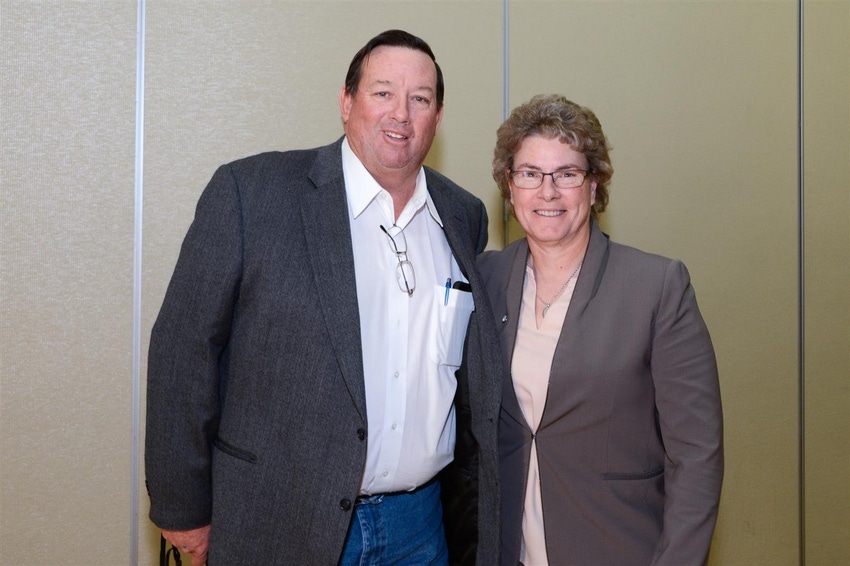
The last two years was a tale of extremes for the American pistachio industry. What was by most accounts a “crop failure” in 2015 was followed in 2016 by production more than three times the amount and nearly twice the previous all-time record.
Perhaps such a record – over 903 million pounds of pistachios were harvested in California, Arizona and New Mexico in late 2016 – is fitting for an industry organization celebrating its 10th anniversary, though it wasn’t just total production the American Pistachio Growers (APG) had cause to celebrate at its annual conference held in February in Palm Desert, Calif.
While pistachio acreage is not reported in Arizona and New Mexico it's reported in California. Bearing acreage in California reached an all-time high in 2016 at more than 239,000 acres. Non-bearing acreage continues to range between 50,000 and 100,000 for the ninth consecutive year, a testament to the popularity of new plantings over the past decade.
New pistachio plantings in California have ebbed and flowed since 1997, according to APG records. California growers planted nearly 25,000 acres of pistachios in 2007 and again in 2013. Those 2007 plantings are now considered “bearing,” while the estimated 90,000 acres planted since 2010 remained “unbearing” as harvest got under way last September.
Richard Matoian, executive director of the volunteer trade association, reported some other high-points at the industry’s annual convention.
The estimated 250,000 bearing acres of pistachios across the three-state region is expected to rise well above 300,000 by 2021. By then, the industry expects its first-ever billion-pound harvest, which according to Matoian could come as early as 2018. Because of the alternate-bearing nature of pistachios, Matoian says the industry does not expect the 2017 harvest to come in as high as last year’s production, but should rebound the following year.
California pistachio growers also saw another high in 2016 as average yields exceeded 3,500 pounds per acre. This compares to about 1,000 pounds per acre growers averaged the previous year when total production failed to reach 300 million pounds.
The phenomenal rise in pistachio production is being met with increased demand and a positive trend in grower prices.
Pistachio shipments in the first five months of the marketing year, which begins Sept. 1 each year, climbed to over 80 million pounds domestically, while more than 230 million pounds were exported during the same period. At this rate, Matoian believes total shipments – domestic and international – could eclipse previous records, especially since the highest year on record for exports came in short of 300 million pounds in the 2012/2013 marketing year.
Matoian believes total domestic shipments this year could top 170 million pounds seen in the 2012/2013 marketing year. On the international side, shipments to Hong Kong and China were already at 140 million pounds within the first five months of the marketing year.
“I know we will break records in total shipments this year,” Matoian says.
Other records set this year includes total conference attendance, at just under 900 people. Matoian and board members were also boasting how the conference has been self-funded for two years running, meaning no grower assessment dollars paid for the conference. All conference activities were funded through registrations and corporate sponsorships.
“Without our sponsors, we wouldn’t be able to put on the quality conference that we have,” Matoian says. “Being totally self-funded is an incredible achievement.”
Marketing
APG conducts non-branded marketing, only generic promotions, according to Judy Hirigoyen, vice president of global marketing. The generic marketing aims at convincing consumers to make American pistachios part of their diet regardless of company labels.
APG’s generic promotion activities includes nutrition research, educational programs targeted at health professionals and food professionals, consumer education and product sampling, and public relations.
Each year, the organization targets 75-80 percent of its budget to marketing, Matoian says. The organization also funds a portion of its promotions activities through grants, including Farm Bill Market Access Program funding.
Through the efforts of APG, Hirigoyen says domestic kernel shipments have grown 62 percent since 2010/2011. They now account for about 18 percent of total domestic shipments and more than 10 percent of total shipments.
Kernel shipments to APG target markets in the European Union, China, South Korea and the U.S. have grown 42 percent in the same period, she said.
APG continues its ambassador programs that include promotions featuring Miss California and the USA Water Polo team. New this year to the line-up of celebrity ambassadors is Miss Arizona, who was introduced at the recent annual conference.
Nutrition
APG is using partnerships with publications like Men’s Health and nutrition research boasting the health benefits of a diet that includes pistachios to further sales as American farmers produce more pistachios.
Press conferences, events with noted chefs, retail promotions and other activities in China are helping to boost sales, according to Haiying Zhang, APG’s director of Asian markets. Fueling nut purchases in China is the country's growing diabetes crisis.
Press events in Europe have also worked well to market American pistachios, says APG Marketing Manager Rebecca Hall. APG has also leveraged positive press coverage through positive coverage on the CBS program “The Doctors.”
According to Hirigoyen, consumption trends in pistachios are 32 percent higher since 2008; beating almonds, peanuts and walnuts in rate of growth even though almonds and peanuts still have higher actual consumption when surveying U.S. adults.
Reevaluating the industry
Matoian gave conference-goers a brief look back at the first decade for the organization. Since 2008, APG grower membership has grown 97 percent to nearly 700.
Budgets have also grown as more members came on board. The 2007 harvest season gave APG a budget of about $1.4 million. Today that budget tops $15 million.
“As the industry has grown, so has the organization," Matoian says.
In March, the APG board met to update the organization’s strategic plan which could possibly include new goals and vision for the growing trade association.
About the Author(s)
You May Also Like






